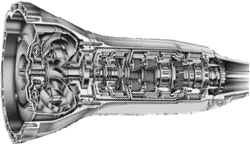Automatic Transmission
The transmission is a system of gears which transmits the power from the cars engine to the drive shaft. The automatic transmission will sense automatically what power(torque) is required to propel the vehicle most efficiently. Think of it like your old ten speed bicycle, the smallest sprocket at rear wheel delivered the maximum torque, great for starting but would become inefficient at higher speeds making it necessary to "change gears" to reduce the power required to turn the wheel at the same speed.
The automatic transmission is coupled to the engine through a torque converter. The torque converter is used with an automatic transmission, because it does not have to be manually disengaged by the operator each time the vehicle is stopped. Because the automatic transmission shifts without any interruption of engine torque application, the cushioning effect of the fluid coupling within the torque converter is desirable.
Because the automatic transmission shifts gear ratios independent of the operator, it must do so without the operator releasing the throttle. The automatic transmission does this by using planetary gearsets whose elements are locked and released in various combinations that produce the required forward and reverse gear ratios. The locking of the planetary gearset elements is done through the use of hydraulically actuated multiple-disc clutches and brake bands. The valve body controls the hydraulic pressure that actuates these locking devices. The valve body can be thought of as a hydraulic computer that receives signals that indicate vehicle speed, throttle position, and gearset lever position. Based on this information, the valve body sends hydraulic pressureto the correct locking devices.
Transmission Filter and Fluid Replacement

Must of us don't think twice about getting the engine oil changed, most people understand it will lengthen the life of the automobile. What most of us overlook is how important it is to follow your manufacturer's recommendation to replace/change your transmission fluid. Transmission repairs can be costly! Make sure when you have your transmission fluid changed they also replace the filter. Replacing the filter is necessary for long and trouble-free operation of your transmission. Service your transmission and keep your pride and joy running smooth.
Fluid replacement is to be performed according to the manufacturer’s recommendations. These recommendations vary considerably for different makes and models. When you change automatic transmission fluid, always read the service manual first.
Service intervals depend on the type of use the vehicle receives. Depending on where you live, because of the operating environment, more than a few of the vehicles are subjected to severe service. Severe service includes the following: hot and dusty conditions, constant stop and go driving (taxi service), trailer towing, constant heavy hauling, and around the clock operations (contingency). Any Vehicle operating in these conditions should have its automatic transmission fluid and filter changed on a regular schedule, based on the manufacturer's specifications for severe service. Ensure the vehicle is on level ground or a lift and let the oil drain into a proper catchment device.
Note: Not all transmission fluids are the same. Before you add fluid, check the manufacturer’s recommendations first. The use of the wrong fluid will lead to early internal parts failure and costly overhaul.
Linkage and Band Adjustment
The types of linkages found on an automatic transmission are gearshift selection and throttle kickdown. The system can be a cable or a series of rod and levers. These systems do not normally present a problem, and preventive maintenance usually involves only a visual inspection and lubrication of the pivot points of linkages or the cable. When adjusting these linkages, you should strictly adhere to the manufacturer’s specifications.
If an automatic transmission is being used in severe service, the manufacturer may suggest periodic band adjustment. Lockup bands are always adjusted to the manufacturer’s specifications. Bands are adjusted by loosening the locknut and tightening down the adjusting screw to a specified value. The band adjusting screw is backed off a specified amount of turns and the locking nut tightened down. NOT ALLBANDS ARE ADJUSTABLE. Always check the manufacturer’s service manual before any servicing of the transmission.
